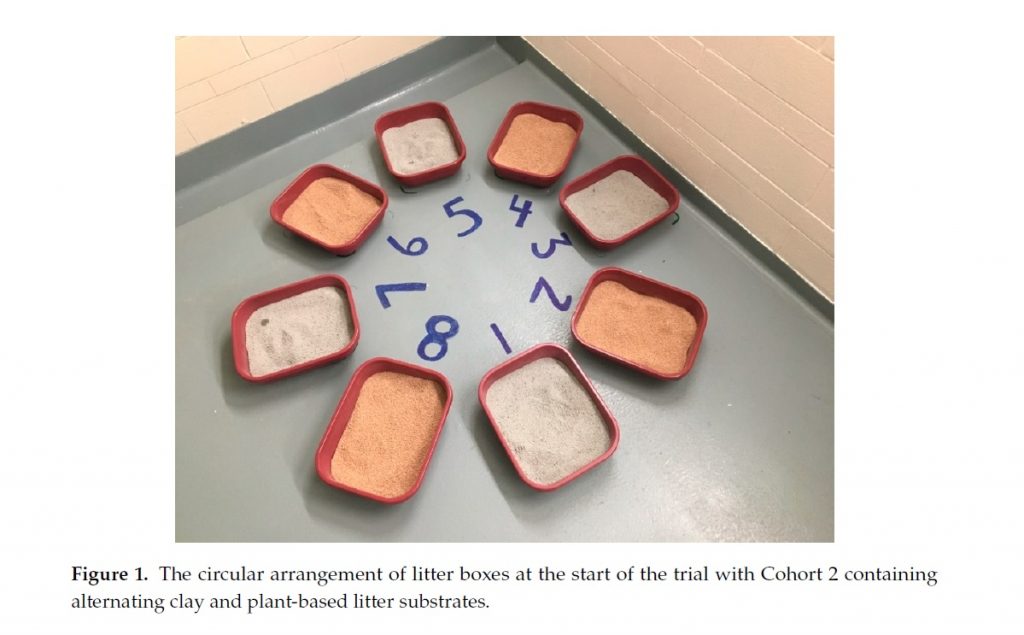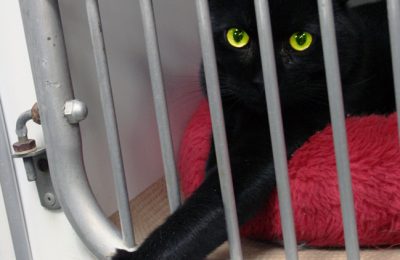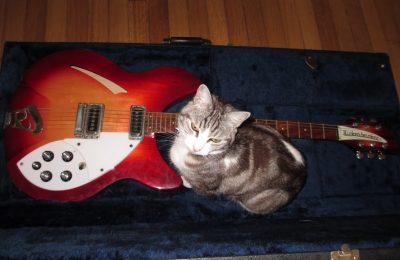What do cats love about their litter box? Well it might depend…as I’ve blogged about before, research as clearly demonstrated the importance of cleanliness, and we can use cats’ behaviors to help us better understand when they are having a good experience in their kitty commode. And when they aren’t having a good experience? That is when you are likely to find cat urine on your backpack, your bathmat, your bed, your tub, your fruit basket, your shoes, oh and all kinds of other very strange and interesting places.
A new study adds another piece to the puzzle, testing the effect of a litter attractant on the box behaviors of sixteen cats.
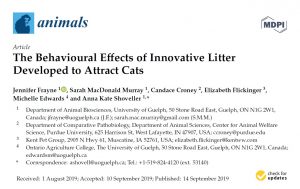 The study, The behavioural effects of innovative litter designed to attract cats, was a collaboration between the University of Guelph, Purdue, and the funders, the Kent Pet Group (more on them later). Previous studies have shown that cats prefer clay clumping litter compared to other types (pellets and pearls). Likely due to the sensitive nature of cats’ feet as well as their desire to dig and scratch in a substrate before and after eliminating, they prefer a very fine-grained litter.
The study, The behavioural effects of innovative litter designed to attract cats, was a collaboration between the University of Guelph, Purdue, and the funders, the Kent Pet Group (more on them later). Previous studies have shown that cats prefer clay clumping litter compared to other types (pellets and pearls). Likely due to the sensitive nature of cats’ feet as well as their desire to dig and scratch in a substrate before and after eliminating, they prefer a very fine-grained litter.
However, some cat owners do not like clay litter, and are looking for something that might be more environmentally friendly, or less dusty than clay litter, which can often send them down to the pet store in search of alternatives. Sometimes those alternatives cause more problems than they solve (TIDY CAT BREEZE and FELINE PINE, I’m looking at you – your products should come with warning labels). But how do cats feel about alternative litters? And can they be made more attractive with an “attractant”? That’s what the current study sought to find out.
The cats were brought into the lab from an animal shelter for about a month – the duration of the study (and they were all adopted out into homes after the study). The cats were housed in groups of eight, and their room had perches, hiding spots, beds and toys. The cats received social visits during the study.
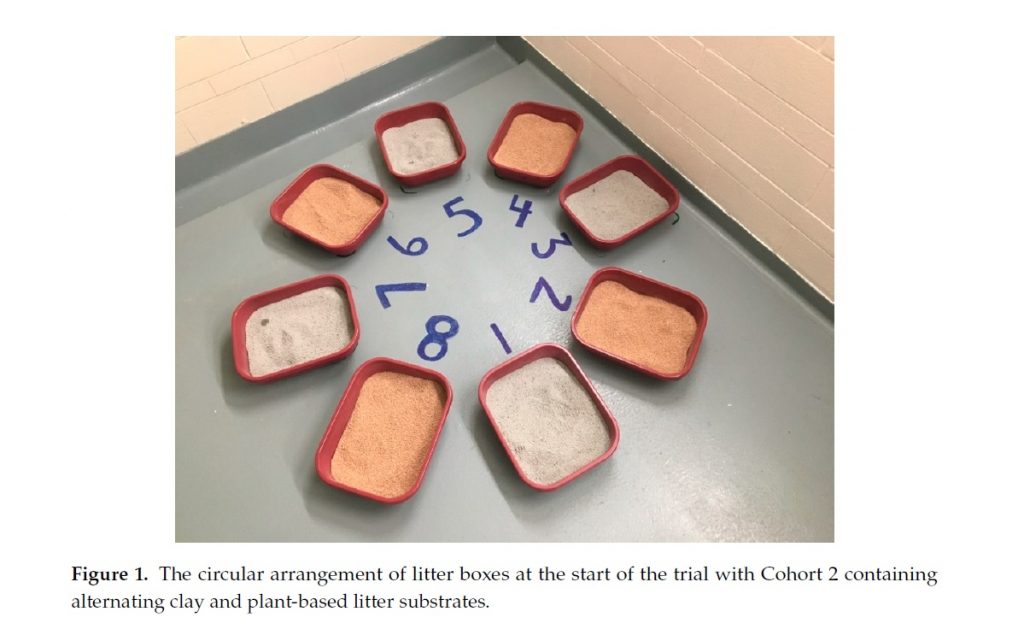
Each group of cats had access to eight litter boxes that were cleaned twice daily. At first, half of the boxes had clay litter and the other half had a plant-based litter, and the cats were gradually transitioned to 100% plant-based litter by mixing the two, increasing the amount of plant-based litter in the clay litter boxes each day.
After about a week of transitioning, the test began, which was to compare the cats’ use of plant-based (PB) litter with a PB litter that included an ”attractant” (PB+ATTRACT; although the nature of this attractant is not revealed). Half of the boxes had PB+ATTRACT in them and the other half just had plain old PB litter. Video cameras were installed so litter box behaviors (digging, covering, number of paws in the box, sniffing, and whether the cat actually peed or pooped) could be assessed over the next few weeks.
The key findings included that, NO SURPRISE!! Cats really went to town in the box right after it had been scooped. They also seemed to prefer the location of one box (#3) and used that one more than any other box, which may have impacted the results (this box contained the plain PB litter without attractant added). Also, none of the cats eliminated anywhere besides a litter box during the duration of the study.
Did the cats prefer the litter with the attractant? The only difference was that the cats urinated significantly more often in the PB+ATTRACT litter. There were more effects of the sex of the cat, such that males spent more time covering and sniffing their eliminations compared to the female cats in the study. This behavioral difference has been found in other studies and likely reflects some of the behaviors related to mating that are retained even in neutered cats.
As I’ve mentioned before, litter box use does not equal preference. This study would have been strengthened if they had compared the PB litter with a clay-based litter of similar texture. But I think that would have gone against the funding source’s interest. The Kent Group, who funded the study, is the maker of “World’s Best Cat Litter” – so I’m guessing that the unnamed products in this study are WBCL and their new formulation that includes an “attractant.” My own experience as a consultant is that plenty of cats will use this litter, but a fair amount will not, and when tested with other choices, cats do not tend to prefer it. I appreciate that a company is willing to publish their findings, as many corporations keep their research under wraps.
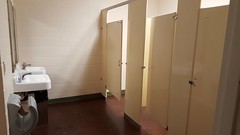
Picture by Jeff Barton via a Creative Commons License
Behaviors were only recorded during daytime hours, which may have limited observations of some cats who may prefer to eliminate overnight. The researchers also could have rotated the positions of the litter boxes with PB and PB+ATTRACT litter to eliminate any influence of litter box location. Another issue with the way the study was set up is that all of the litter boxes were in the same general location, which is not recommended in a home environment. Cats may experience multiple litter boxes that are side by side as one “elimination area” rather than separate boxes, which may make the area less attractive (think of the difference to us between a public restroom with a bunch of stalls versus one that is private!). This litter box crowding may have made some cats uncomfortable when eliminating, especially if all cats were interested in using the boxes right after they had been cleaned. An alternative approach would have been to have multiple locations in the enclosure that had the two types of litter side by side.
The finding that cats preferred to urinate in PB+ATTRACT litter is important – urinating outside of the box is an issue that sends many cats to the shelter, or even to their death, so anything that increases a cat’s interest in the litter box is good to be aware of. However, my mantra for your own cat is to give them some choices (here’s a quick guide), and let them tell you what they like…and SCOOP SCOOP SCOOP!!!!!!!
Reference:
Frayne, J., Murray, S. M., Croney, C., Flickinger, E., Edwards, M., & Shoveller, A. K. (2019). The Behavioural Effects of Innovative Litter Developed to Attract Cats. Animals, 9(9), 683.

